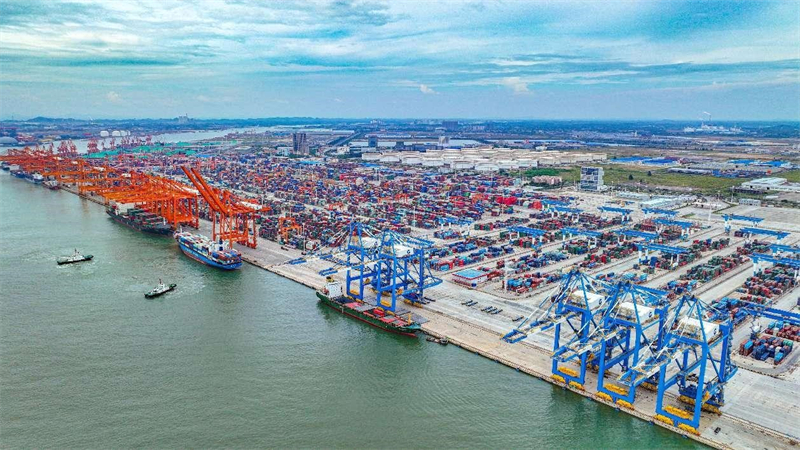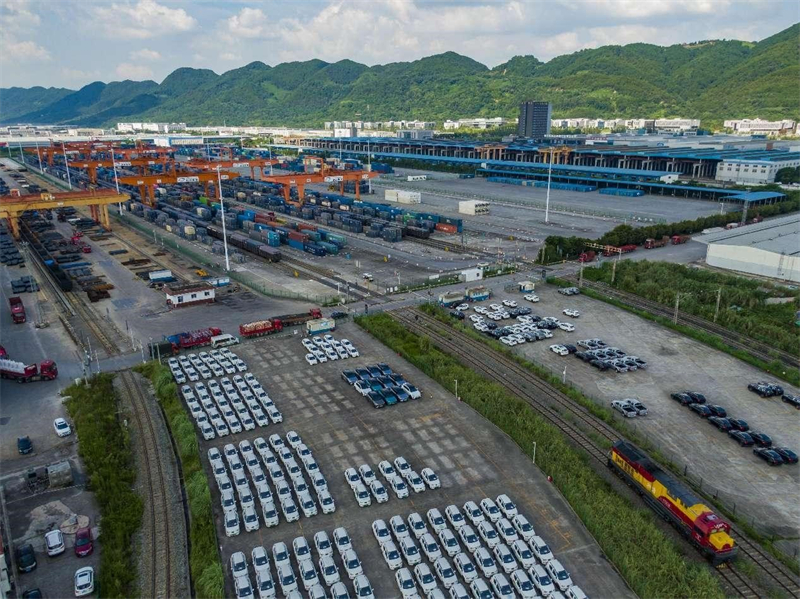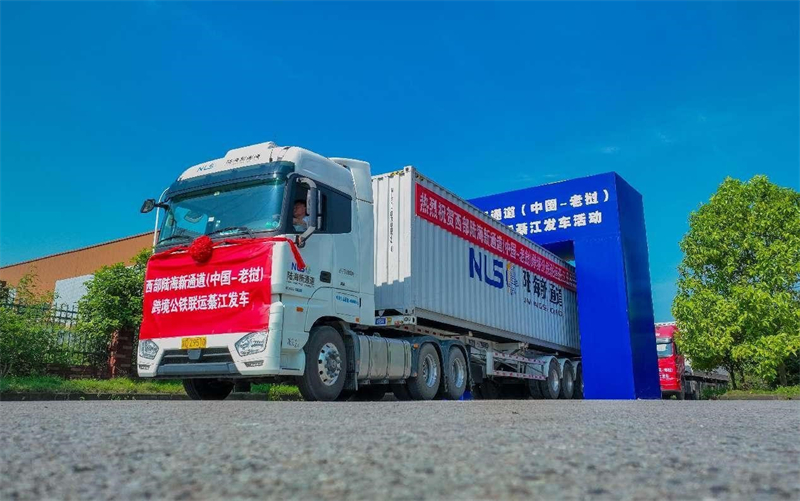China vigorously advances construction of New International Land-Sea Trade Corridor
The New International Land-Sea Trade Corridor is an international trade and logistics passage jointly built by Chinese provincial regions and ASEAN countries.
The passage takes provincial regions in western China as key transportation hubs and stretches southward to destinations across the globe, making use of various transportation modes including railway, maritime shipping and highway.

Photo shows an automated terminal of the port of Qinzhou, south China's Guangxi Zhuang autonomous region. [People's Daily Online/Feng Rongquan]
In recent years, China has been vigorously promoting the construction of the New International Land-Sea Trade Corridor. According to statistics, the trade volume between the 13 provinces, autonomous regions, and municipalities jointly building the passage and the ten ASEAN countries exceeded $130 billion last year, an increase of 73.3 percent compared to that in the beginning of the corridor's operation in 2017. This figure has exceeded $100 billion for three consecutive years.
Rail-sea intermodal trains departing from Chengdu International Railway Port in Chengdu, capital of southwest China's Sichuan province, for south China's Guangxi Zhuang autonomous region have been operating steadily with a continuous increase in shipment volume.
According to Huang Jun, director of the dispatching workshop of the Chengdu North Railway Station under China Railway Chengdu Group, the Sichuan-Guangxi rail-sea intermodal trains, which start from Chengdu and export cargos to ASEAN countries via the port of Qinzhou in Guangxi, reduce shipping time by over a half compared with traditional river-sea transportation.
And more changes are happening to forge better connectivity.
A new rail line between Chengdu and Kunming, capital of southwest China's Yunnan province, was opened at the end of 2022. The railway, together with the international freight line of Lancang-Mekong Express, shortens the trip between Chengdu and Laos' capital Vientiane to two days and 17 hours.
In July this year, the Lancang-Mekong-Sichuan Express was launched. The train service originates from Rayong province, Thailand, and travels via the China-Laos Railway from Vientiane to Chengdu International Railway Port. It then heads to Budapest, Hungary in Europe, through China-Europe freight trains.
The service connects the China-Laos Railway and the China-Europe freight train service, reducing the logistics transit time to a minimum of 15 days.

Vehicles to be shipped are parked in an international logistics park in southwest China's Chongqing municipality. [People's Daily Online/Sun Kaifang]
As of October this year, the New International Land-Sea Trade Corridor had established 139 logistics stations in 69 cities of 18 provinces, autonomous regions, and municipalities in China, reaching 480 ports in 120 countries and regions worldwide.
In the first three quarters of this year, the rail-sea intermodal trains of the New International Land-Sea Trade Corridor transported 633,000 twenty-foot equivalent unit (TEU) containers of goods, growing 14 percent year on year.
"In addition to the rail-sea intermodal transport, other modes of transportation such as the rail-road, river-rail-sea, road-sea and the air transportation are also being developed rapidly," said Liu Wei, director of the logistics and operation coordination center of the New International Land-Sea Trade Corridor.
Provinces, autonomous regions, and municipalities involved in the construction of the New International Land-Sea Trade Corridor are working together to promote the deep integration of transportation modes, establishing an efficient intermodal transport system for Asian and European countries and regions, Liu noted.
As hardware facilities are becoming more advanced, the level of logistics operations and service support is also improving. Guizhou and Yunnan provinces are implementing Regional Comprehensive Economic Partnership (RCEP) rules in the construction of the New International Land-Sea Trade Corridor according to their respective local conditions. Chongqing municipality has comprehensively implemented a fast customs clearance mode for railways and innovating new forms of foreign trade.
What's even more gratifying is that this passage is now empowered by digital development. By building digital and information platforms, provinces, autonomous regions and municipalities jointly constructing the New International Land-Sea Trade Corridor have launched a series of convenient online services.

A truck carrying motorcycle parts manufactured by Fuego, a company in Qijiang, southwest China's Chongqing municipality, leaves the company's plant. The motorcycle parts are exported to Laos via rail-road transportation of the New International Land-Sea Trade Corridor. [People's Daily Online/Chen Xingyu]
For example, the international trade "Single Window" of Ningxia Hui autonomous region has launched 781 services in 19 major categories, and 38 types of import and export regulatory certificates can be applied through the "Single Window." Xinjiang Uygur autonomous region is promoting the integration of 5G, new infrastructure, and transportation infrastructure, enhancing the sharing capabilities of information platforms, and promoting the intensive and efficient development of transportation resources.
In 2022, 78 routes were opened along the New International Land-Sea Trade Corridor, bringing rice from Laos and durians from Thailand to China and Europe, and taking specialties of west China like Guizhou's chili sauce to overseas destinations.
Leveraging advantageous industries such as automotive and electronic information, Chongqing saw its trade volume with Belt and Road countries and regions reach 333.14 billion yuan ($46.81 billion) last year. The municipality has attracted investment from 319 Fortune Global 500 companies.
Chinese enterprises have collaborated with Laos to develop modern agricultural industrial parks, and are exploring an integrated banana supply chain featuring transport, trade and production with Cambodia.
These vivid examples demonstrate how the New International Land-Sea Trade Corridor facilitates industrial development.
The New International Land-Sea Trade Corridor has become a vital link in promoting a smooth dual circulation, Liu told People's Daily.
It drives global division of industries and cooperation, and connects west China with the Southeast Asian and European markets, which will contribute to high-quality development, Liu added.
























